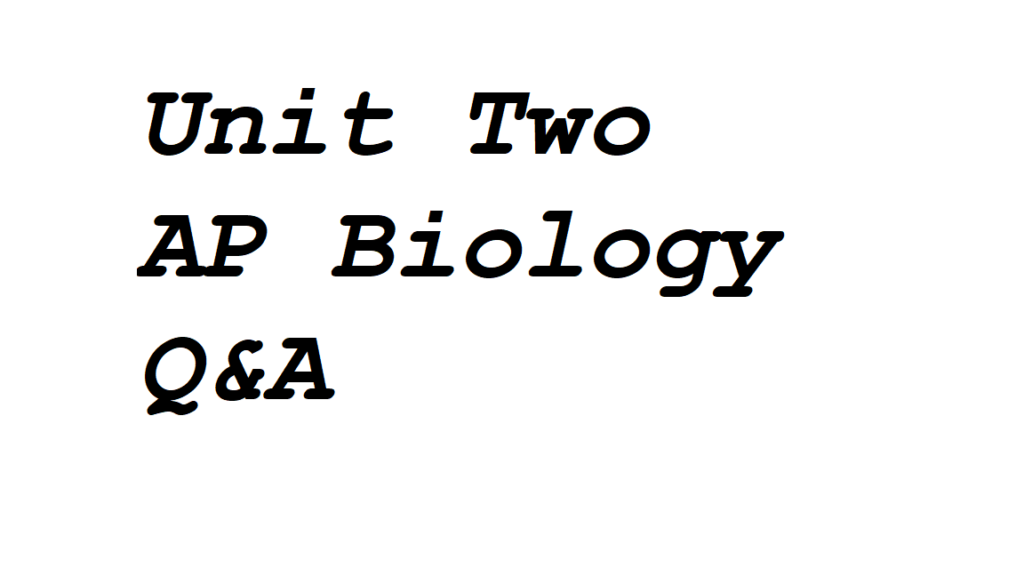AP Biology Unit 2 – Cell Structure & Function
Unit 2 of AP Biology covers the structure and function of cells, including membrane transport, organelles, and cell communication. These topics are essential for understanding how life operates at the cellular level.
To help you prepare for the AP Bio exam, we’ve compiled essential questions with detailed answers and explanations on these topics.
1. What Are the Differences Between Prokaryotic and Eukaryotic Cells?
Question:
How do prokaryotic and eukaryotic cells differ in structure and function?
Answer:
Prokaryotic cells (bacteria & archaea) are simpler, while eukaryotic cells (plants, animals, fungi, protists) are more complex.
| Feature | Prokaryotic Cells | Eukaryotic Cells |
|---|---|---|
| Nucleus | No nucleus (DNA in nucleoid) | Has a nucleus |
| Organelles | No membrane-bound organelles | Has membrane-bound organelles |
| Size | Smaller (1-10 µm) | Larger (10-100 µm) |
| Examples | Bacteria, Archaea | Plants, Animals, Fungi, Protists |
💡 AP Exam Tip: Prokaryotes lack mitochondria, so they perform cellular respiration in the cell membrane instead!
2. What Are the Functions of Key Cell Organelles?
Question:
What are the functions of the major organelles in eukaryotic cells?
Answer:
| Organelle | Function | Found in |
|---|---|---|
| Nucleus | Stores DNA, controls cell activities | Plants & Animals |
| Mitochondria | Produces ATP (cellular respiration) | Plants & Animals |
| Chloroplast | Photosynthesis (makes glucose) | Plants |
| Ribosomes | Protein synthesis | All cells |
| Endoplasmic Reticulum (ER) | Rough ER (protein synthesis), Smooth ER (lipid synthesis) | Plants & Animals |
| Golgi Apparatus | Modifies & packages proteins | Plants & Animals |
| Lysosomes | Digests waste & old organelles | Animals |
| Vacuole | Stores water & nutrients (large in plants) | Plants & Animals |
💡 AP Exam Tip: The endomembrane system (nucleus → ER → Golgi → vesicles) is key for protein and lipid transport!
3. What Are the Differences Between Passive and Active Transport?
Question:
How do passive transport and active transport differ?
Answer:
| Transport Type | Energy Required? | Molecule Movement | Examples |
|---|---|---|---|
| Passive Transport | No | High → Low (down gradient) | Diffusion, Osmosis, Facilitated Diffusion |
| Active Transport | Yes (ATP needed) | Low → High (against gradient) | Sodium-Potassium Pump, Endocytosis, Exocytosis |
💡 AP Exam Tip: Facilitated diffusion uses transport proteins, while simple diffusion moves directly through the membrane!
4. How Does Water Move in and Out of Cells? (Osmosis & Tonicity)
Question:
What happens when a cell is placed in hypotonic, isotonic, and hypertonic solutions?
Answer:
- Hypotonic Solution (Low Solute, High Water): Water enters the cell → Cell swells/bursts (lysis).
- Isotonic Solution (Equal Solute & Water): No net movement → Cell stays the same.
- Hypertonic Solution (High Solute, Low Water): Water leaves the cell → Cell shrinks (plasmolysis).
💡 AP Exam Tip: Plant cells thrive in hypotonic solutions (turgid), while animal cells risk bursting!
5. How Do Cells Communicate? (Cell Signaling & Signal Transduction Pathway)
Question:
What are the key steps in cell communication?
Answer:
- Reception: A ligand (signal molecule) binds to a receptor.
- Transduction: The signal is relayed through a cascade of proteins.
- Response: The cell activates a function (e.g., gene expression, enzyme activation).
💡 AP Exam Tip: The G-protein coupled receptor (GPCR) is a key membrane receptor in cell signaling!
6. Practice Questions for AP Biology Unit 2
- Compare the structure and function of prokaryotic vs. eukaryotic cells.
- Explain how ribosomes, ER, and Golgi apparatus work together to synthesize and modify proteins.
- How does active transport differ from passive transport, and why is ATP needed?
- What happens to a plant and animal cell in hypertonic, hypotonic, and isotonic environments?
- Describe the steps of a signal transduction pathway and why it’s essential for cell communication.
7- What is the significance of membrane proteins?
Answer: Membrane proteins play several critical roles, including:
- Transport: Channel and carrier proteins facilitate the movement of molecules across the membrane.
- Signal Transduction: Receptor proteins receive and transmit signals from the environment.
- Cell Recognition: Glycoproteins help cells identify each other, which is essential for immune responses.
- Enzymatic Activity: Some membrane proteins catalyze biochemical reactions.
Explanation: Membrane proteins are essential for communication, transport, and maintaining cell identity. Understanding their functions is key to grasping topics like cell signaling, immune responses, and metabolic pathways.
8- What Are the Main Components of the Cell Membrane, and How Do They Function?
Answer:
The cell membrane is primarily composed of a phospholipid bilayer, proteins, cholesterol, and carbohydrates. Each component plays a specific role:
- Phospholipids: Form the basic structure of the membrane. Their hydrophilic (water-attracting) heads face outward, while their hydrophobic (water-repelling) tails face inward.
- Proteins: Embedded within or attached to the membrane, they serve as channels, pumps, receptors, and enzymes.
- Cholesterol: Stabilizes the membrane and maintains its fluidity.
- Carbohydrates: Attached to proteins or lipids, they help in cell recognition and communication.
Explanation:
The selective permeability of the cell membrane allows it to regulate what enters and exits the cell. This is crucial for maintaining homeostasis. For example, small nonpolar molecules like oxygen can pass freely through the lipid bilayer, while larger or charged molecules require transport proteins.
9. How Does the Sodium-Potassium Pump Work?
Answer:
The sodium-potassium pump is an example of active transport. It uses ATP to move three sodium ions (Na⁺) out of the cell and two potassium ions (K⁺) into the cell.
Explanation:
This pump is critical for maintaining the electrochemical gradient necessary for nerve impulses and muscle contractions. By pumping out more positive charges than it brings in, it helps create a negative charge inside the cell relative to the outside, known as the resting membrane potential.
10-What Are the Stages of Cellular Respiration, and Where Do They Occur?
Answer:
Cellular respiration consists of three main stages:
- Glycolysis: Occurs in the cytoplasm. Glucose is broken down into pyruvate, producing a small amount of ATP and NADH.
- Krebs Cycle (Citric Acid Cycle): Takes place in the mitochondrial matrix. Pyruvate is further broken down, producing NADH, FADH₂, and ATP.
- Electron Transport Chain (ETC): Located in the inner mitochondrial membrane. Electrons from NADH and FADH₂ are transferred through protein complexes, generating a large amount of ATP.
Explanation:
These stages work together to convert glucose into usable energy (ATP). The ETC is particularly important because it produces the majority of ATP through oxidative phosphorylation.

Study AP Biology
Practice Digital SAT
Find us on Facebook
